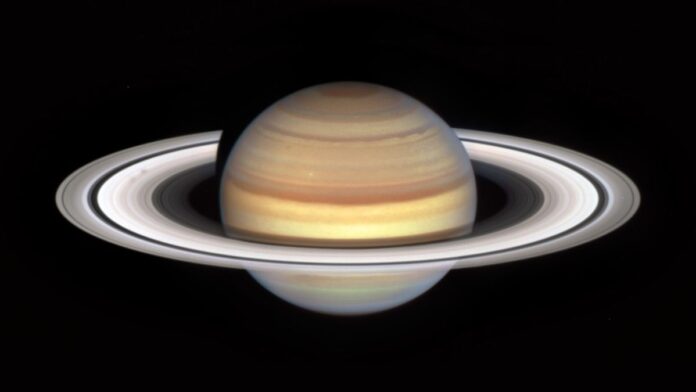The Hubble Space Telescope captured mysterious features on Saturn’s rings, signaling the start of the planet’s “spoke season.”
Like Earth, Saturn is tilted on its axis and has four seasons. However, since Saturn is farther out in the solar system and has a much larger orbit around the sun, each season lasts approximately seven Earth years, according to a statement (opens in new tab) from NASA.
When the planet’s rings tilt edge-on toward the sun, the planet is undergoing an equinox, creating the mysterious lines known as spokes, which can be observed on its rings. These spokes will become even more prominent as the planet’s northern hemisphere approaches its fall equinox on May 6, 2025.
Related: Saturn’s Rings: Composition, Characteristics & Creation
“The suspected culprit for the spokes is the planet’s variable magnetic field. Planetary magnetic fields interact with the solar wind, creating an electrically charged environment,” NASA officials said in the statement. “On Earth, when those charged particles hit the atmosphere this is visible in the northern hemisphere as the aurora borealis, or northern lights. Scientists think that the smallest, dust-sized icy ring particles can become charged as well, which temporarily levitates those particles above the rest of the larger icy particles and boulders in the rings.”
The spokes on Saturn’s rings were first observed by NASA’s Voyager mission in the early 1980s. The planet’s last equinox, which occurred in 2009, was observed by the space agency’s Cassini spacecraft. Now, Hubble is keeping a close eye on our ringed neighbor as part of a program called the Outer Planet Atmospheres Legacy (OPAL).
“Thanks to Hubble’s OPAL program, which is building an archive of data on the outer solar system planets, we will have longer dedicated time to study Saturn’s spokes this season than ever before,” Amy Simon, senior planetary scientist at NASA and head of the OPAL program, said in the statement.
The Hubble Space Telescope observations will add new perspective on Saturn’s mysterious spokes by offering both visual and spectroscopic data in wavelengths of light from ultraviolet to near-infrared. Combined with archived Cassini observations, the researchers hope to gain a more complete picture of the spoke phenomenon, and what it reveals about ring physics in general.
“Despite years of excellent observations by the Cassini mission, the precise beginning and duration of the spoke season is still unpredictable, rather like predicting the first storm during hurricane season,” Simon said.
The spokes on Saturn’s rings may appear dark or light depending on the illumination and viewing angle. Although visible now, the spokes disappear during the planet’s summer or winter solstice, when the sun is at its highest or lowest latitude in the northern or southern hemisphere.
Saturn is the only ringed planet in our solar system where spokes have been observed. However, Saturn’s ring system is much more prominent than the other ringed gas giants in our solar system: Jupiter, Uranus and Neptune.
“It’s a fascinating magic trick of nature we only see on Saturn — for now at least,” Simon added in the statement.
Follow Samantha Mathewson @Sam_Ashley13 (opens in new tab). Follow us @Spacedotcom (opens in new tab), or on Facebook (opens in new tab) and Instagram (opens in new tab).

